Media | Articles
MacGyvering the freshwater pump in the RV
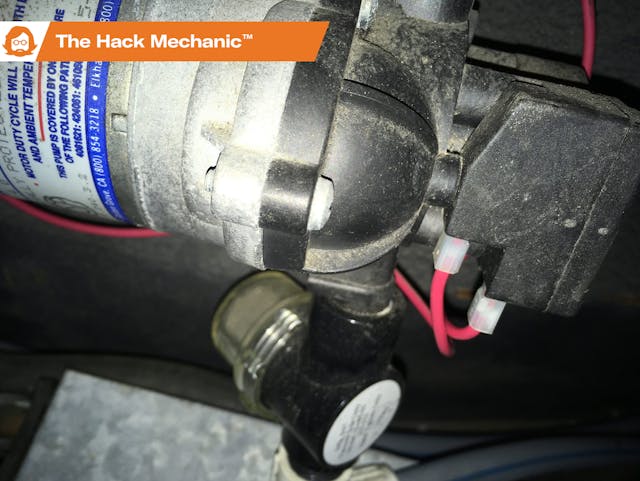
I did a lot of work this spring on our little Winnebago Rialta RV, which is a Volkswagen Eurovan with a Winnebago camper body on the back. Most of the work was targeted at addressing the two unforgivable things Winnebago did in the conversion—not up-rating the rear wheel bearings or the transaxle for the extra weight from the RV conversion.
I finished installing a set of heavy-duty rear wheel-bearings, which slippery-sloped its way into rebuilding the rear brakes and replacing the air springs. I also installed a transmission cooler and a temperature gauge to reduce and monitor transaxle temperature. Although I’m still hesitant to take the little five-cylinder, 110-horsepower rig on a long western road trip with big hill climbs, I certainly now feel more secure tooling around New England in it.
And, in a purely appearance-related purchase, I spent a hundred bucks and bought a used set of proper Volkswagen Eurovan hubcaps, as the generic $50 Amazon hubcaps I tried looked absolutely horrible on it.
My wife Maire Anne found us a spot for a few nights at the campground in Wompatuck State Park hear Hull, Massachusetts, the peninsula that bounds the southern side of Boston Harbor. The 40-minute drive down from Newton was the perfect short shakedown for the RV. I brought my small travel toolbox, but not the full-on road-trip attack setup. Everything worked flawlessly.
Until we arrived.
Marketplace
Buy and sell classics with confidence
As I’ve written before, a small RV like the Rialta straddles the line between camper and motorhome (technically, an RV has a bathroom and a black water tank, but a camper doesn’t), and part of owning one is finding out where you self-identify on the spectrum of camper owners versus RV owners. Dovetailing with that is the overlap between campgrounds and RV campgrounds. A “campground” may have nothing at the campsites except an unpaved spot to park your vehicle and pitch your tent. If instead of a tent, you want to pop up the top of your old-school VW Westfalia camper or unfold the wings of your little Coleman pop-up trailer, that’s fine.
Or the campsites may have additional services. There may be electricity (120 volts a/c, which may present itself as a standard electrical outlet or an RV-specific 20-amp or 40-amp plug). Even if you’re simply tenting, an electrical outlet is great for running the coffee maker or the laptop. The gray area really begins when campsites have a water spigot. Granted, VW Westfalia campers and many Coleman pop-ups have water tanks and a small sink, but the combination of electricity and water really caters to RVs. When you fully cross the line to RV campgrounds, each site is usually large enough to hold a full-sized Class A (bus-style) RV and has a cement or asphalt pad on which to park it, and the site may also have a dump port so you can connect a hose to the black water tank and leave it there instead of having to drive the rig to a centralized dump station to empty the tank.
With that background, the campsite Maire Anne had booked at Wompatuck had electricity but no water. That was fine. The Rialta has a 20-gallon freshwater tank, a 13-gallon black water tank, and a 9-gallon grey water tank. Together, they work well for a few days of toilet flushing and hand washing. Showering, though, is another issue. The shower in the Rialta is a “wet bath” co-located with the toilet like some small boats have. And the hot water tank holds only four gallons. The tiny size of the shower and hot water tank, and the modest size of the grey water tank means that we almost never use the shower; we instead rely on the showers in the campground facilities with their larger size and nearly endless supply of hot water. So the main effect of the campsite not having water was that we’d need to turn on the RV’s electric water pump whenever we needed to use the water instead of relying on the built-in water pressure from a hose hooked up to a spigot. Normally, this isn’t a problem, but it figured centrally in what unfolded.
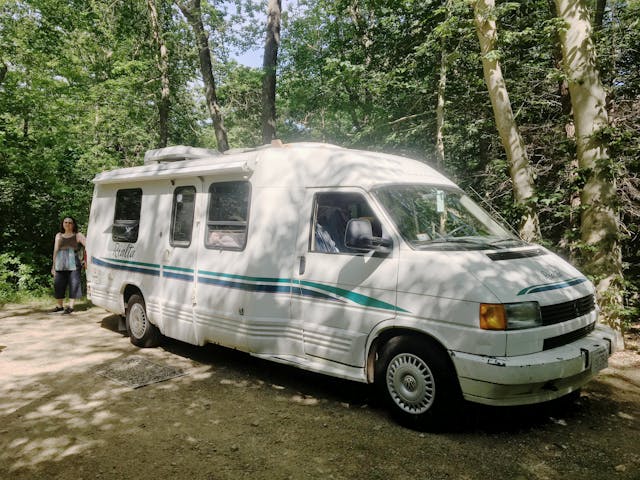
When we arrived at the campsite, I connected the power cable to the electrical box to verify that the site’s electricity was working. I then opened up the bathroom door and found that a fair bunch of dirt had shaken loose and fallen down from the ceiling vent fan during the drive. I went to moisten a paper towel to wipe it off. This meant hitting the switch to turn on the water pump. But to my surprise, when I hit the switch, I heard nothing, and the indicator light for the pump wasn’t illuminated.
Hmmmm.
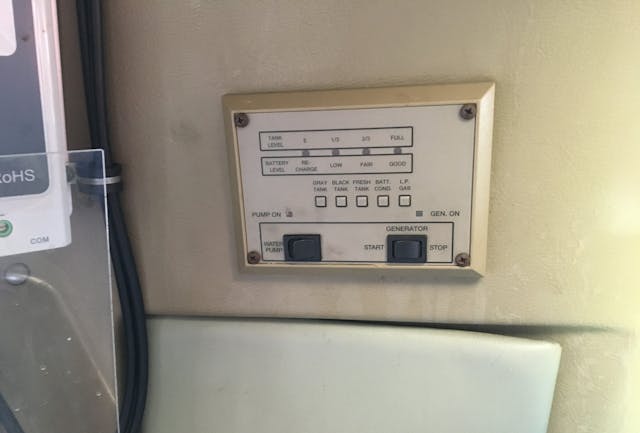
I’d replaced the head on this water pump a few years back. It was a bit of a pain, as it’s under one of the twin bed mattresses and is only reachable through a little hatch about the size of a paperback book. Of course, it was possible the pump itself had gone bad.
My next thought was a fuse. However, while the vehicle (the “cab”) part of the RV has the usual two-dozen fuses, the “coach” part has only a few breakers, and the one for the water pump wasn’t tripped.
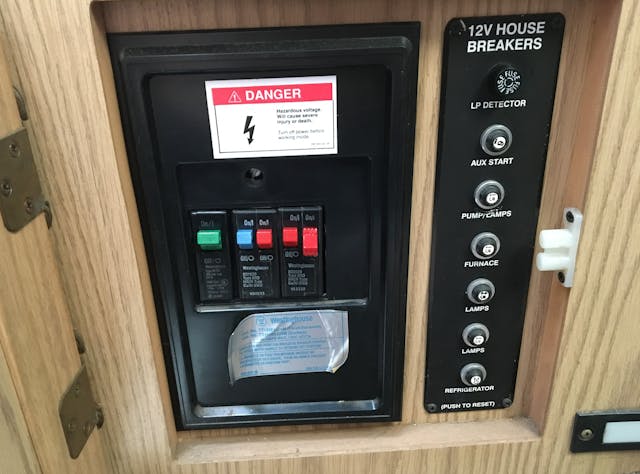
OK, so, not a fuse or a breaker. The next step is to check voltage at the pump and at the switch.
And then it dawned on me: Since this was such a short trip, I’d left my electrical troubleshooting box—the one with the multimeter, the length of lamp cord, the crimping tool, the connectors, and the electrical tape—at home. Damn.
Now, there are two basic ways to troubleshoot a basic something-doesn’t-work electrical problem. Some professional technicians rely on wiring diagrams. That’s great if you have that skill, but despite my having written an automotive electrical book I hate wiring diagrams and find that most of the time they’re not necessary. It’s generally pretty rare that something is a “wiring problem.” Other than on high-flex connections to hatches and doors, the odds of wires breaking somewhere in the middle are pretty slim. The problem is nearly always in one of the components or its connections. So, without a multimeter to measure voltage, the first thing I wanted to do was wire the pump directly to the battery and see if it turned on.
Then I realized—no electrical troubleshooting box, no length of two-conductor lamp cord.
Hmmmm a second time.
I alerted Maire Anne to all this and said that we might need to make a run to a hardware or automotive store. But then I thought… no. It’s four in the afternoon. We have no time pressures. I should be able to MacGyver this. Hell, I don’t even need to invoke MacGyver—I should be able to Hack this.
I’ve had the need for wire to jury-rig things many times over the decades. Usually the go-to source is the wire connecting the speakers to the in-dash stereo, but these things in the Rialta were not easily reachable. I hunted around in the back cabinets and found a 10-ft extension cord. I took my Swiss Army knife, chopped the plugs off, and separated and stripped the ends of the wires.
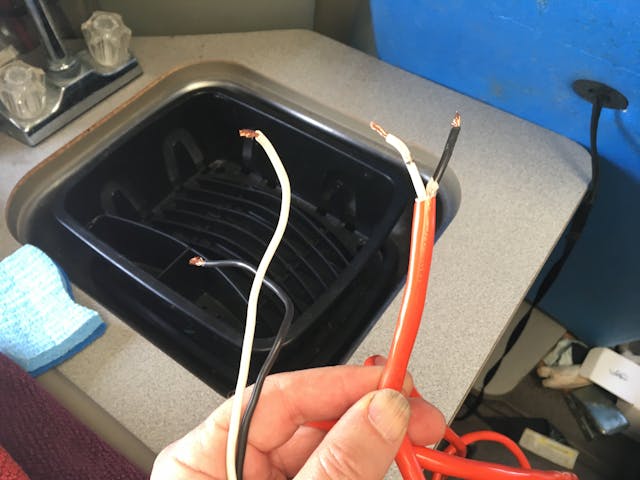
I pulled everything off the left-side twin bed, dragged it onto the other bed, and flipped over the board connecting the two beds that also hides the access hatch for the pump. Then, with wire in hand, I connected one end to the + and – terminals of one of the coach batteries, and carefully touched the other ends of the wires to the pump’s terminals.

The pump immediately whirred to life and pressurized the water system.
This was actually good enough to use the water system—flush the toilet, wash hands, etc—because the system remains pressurized for a while. But not for hours, and I couldn’t leave the mattress off and the inspection hatch exposed to start the pump each time we needed it. If I had female spade connectors, I could crimp them to the ends of the wire, affix them to the pump, put the mattress back in place, run the former extension cord across the floor, and touch the wires to the battery whenever I needed to pressurize the system, but I didn’t. A trip to AutoZone would’ve solved the problem, but I wanted to continue on my self-reliant path.
So I unscrewed the panel that the water pump switch was on.
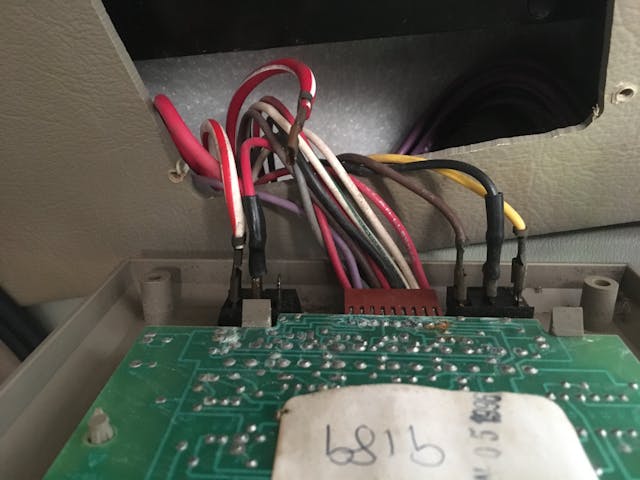
Without a multimeter, I couldn’t directly measure if voltage was coming into the switch, but by turning the switch on, connecting and disconnecting the connectors, and looking carefully for the tiny spark of electrical contact, I concluded it wasn’t. So I took my troubleshooting wire and touched the lead from the positive terminal of the battery to the switch terminal I assumed went to the water pump. It fired up immediately.
Hmmmm a third time.
This actually was a solution that was workable for the rest of the short stay—I could simply leave the panel down and touch the wire to the back of the switch to pressurize the water system. But it made me wonder. Unless the switch was bad—and it didn’t seem like it was—my “component theory” of electrical troubleshooting was on thin ice unless there was another component I was missing.
And then I remembered. There’s a small external washing station behind a panel on the left side of the rig. The idea is that it can be used for washing hands or rinsing sand off feet, but the hand-held wand broke off years ago and I never bothered to replace it. But the moment I thought about it, I remembered that the year after I bought the Rialta, after it sat over the winter, I had this same problem with the water pump not turning on, and I found that there was a second water pump switch at the external hand-washing station. Voltage to the internal switch apparently passes through the external switch. Back then, a few on-off flicks of the external switch were enough to clean off whatever corrosion was on the internal contacts and pass voltage through to the internal switch. This year, unfortunately, dozens of on-off oscillations didn’t cause things to spring to life.
So I pulled the external switch out. As it turned out, this wasn’t easy, because the whole thing was a corroded mess. I had to pry the connector off the back with a screwdriver. But with it off, simple trial and error revealed which pair of terminals I had to jumper in order to pass voltage to the inside switch. Everything was now working perfectly. I wrapped the jumper wire and the connector it was stuck into in duct tape to secure it.
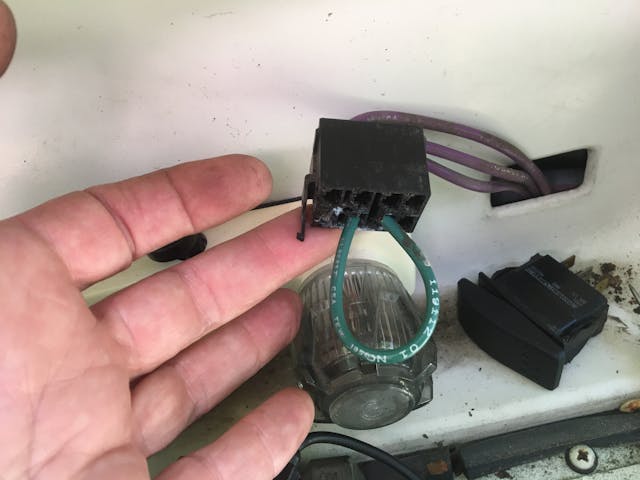
And, with that, I had restored functionality to the RV’s water system. Without a multimeter. Without wire. Without connectors. I felt like Doctor Who when he defeated the Daleks with nothing but a cell phone. Maire Anne, who’d been quietly reading for the hour or so it took me to pull this off, was impressed. “I don’t often get to watch you work, or hear you mumble through your deductive process.”
It may actually have been my favorite part of our little two-day trip. As I’ve said over and over, I can’t fix this increasingly broken world, but it’s precisely because of that that it feels so good when I can fix my little corner of it.
But more importantly, those Eurovan hubcaps look bangin’, right?
***
Rob Siegel’s latest book, The Best of the Hack MechanicTM: 35 years of hacks, kluges, and assorted automotive mayhem, is available on Amazon. His other seven books are available here, or you can order personally inscribed copies through his website, www.robsiegel.com.
















